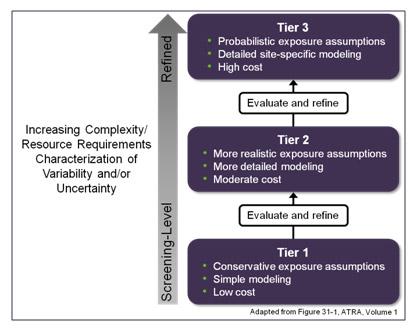Exposure Assessment Tools by Tiers and Types - Screening-Level and Refined
Overview

When conducting a tiered exposure assessment, after each iteration, the question is asked,
Is this level of detail or degree of confidence good enough to achieve the purpose of the assessment?
If the answer is no, successive iterations continue until the answer is affirmative, new input data are generated, or, as is the case for many assessments, the available data, time, or resources are depleted.
(U.S. EPA, 1992) Guidelines for Exposure Assessment
EPA’s Exposure Assessment Guidelines recommend completing exposure assessments iteratively using a tiered approach to
“strike a balance between the costs of adding detail and refinement to an assessment and the benefits associated with that additional refinement” (U.S. EPA, 1992).
In other words, an assessment using basic tools (e.g., simple exposure calculations, default values, rules of thumb, conservative assumptions) can be conducted as the first phase (or tier) of the overall assessment (i.e., a screening-level assessment).
The exposure assessor or risk manager can then determine whether the results of the screening-level assessment warrant further evaluation through refinements of the input data and exposure assumptions or by using more advanced models.
Description
Depending on the purpose and scope of the assessment, an exposure assessor might choose to conduct a very simple assessment based on readily available data and conservative assumptions. This a screening-level assessment![]() screening-level assessmentAn exposure assessment that examines exposures that would fall on or beyond the high end of the expected exposure distribution..
screening-level assessmentAn exposure assessment that examines exposures that would fall on or beyond the high end of the expected exposure distribution..
If a very basic assessment does not yield results that adequately support decision-making, a more detailed, or refined assessment might need to be conducted. This higher-tiered assessment will require data specific to the problem at hand and more resources. Using this iterative approach, exposure assessors can start with a basic approach and layer in complexity as appropriate.
Below are characteristics typical of screening-level and refined assessments. However, they are not necessarily components of all screening-level or refined assessments. For example screening assessments sometimes employ more complex models and site-specific data, but more often these types of assessments use simple models and readily available data. Similarly, not all refined assessments use a probabilistic approach, but this approach is only sometimes used in screening assessments.
| Screening | Refined | |
|---|---|---|
| Inputs |
|
|
| Screening-level assessments typically use readily available data and conservative assumptions to estimate a high-end exposure In contrast, a refined assessment often uses more representative exposure assumptions and inputs. Instead of point estimates, a refined assessment might use a distribution of data to generate multiple points for input into the exposure equation. |
||
| Tools |
|
|
| Screening-level assessments use simple models or more sophisticated models parameterized with default values. These assessments typically use a deterministic approach. A refined assessment often uses site-specific assumptions, modeling or higher-precision sampling and analysis techniques, and probabilistic methods. | ||
| Results |
|
|
| Screening-level assessments are relatively inexpensive and quick to carry out. However, the results contain a high degree of uncertainty Uncertainty can be characterized with a sensitivity analysis A sensitivity analysis following a screening-level assessment could be used to identify the most important variables contributing to exposure. These variables can then be used to determine how best to refine the assessment. For example, it might be used to determine which variables should use distributions of data instead of point estimates in a probabilistic assessment. In a refined assessment, the use of more specific measurement data and sophisticated models may result in a more realistic picture of exposure potential. Refined assessments that use a probabilistic modeling approach may characterize both uncertainty and variability better. |
||
Guidance Tools
The following resources provide information for conducting tiered exposure assessments.
Tools for Assessing Uncertainty and Variability
The following tools are resources for addressing uncertainty and variability.
Methods
- Tools for Planning, Scoping, and Problem Formulation
- Tools for Conducting Screening-Level or Refined Assessments
Thoughtful planning, scoping, and problem formulation at the beginning of the project can help to describe the problem that triggered the assessment and define the question(s) it is intended to answer. Effectively articulating the problem allows the exposure assessor to select the right tier or type of assessment needed. Using the simplest approach possible to answer the question(s), could save time and resources.
In many cases, the assessment process is iterative, and a screening-level assessment might be followed by one or more assessments in which the quality of inputs and results are refined as shown in the figure below.
 Example Application of Tiered Approach to Exposure Assessment (U.S. EPA, 2004)
Example Application of Tiered Approach to Exposure Assessment (U.S. EPA, 2004)
Example of Application of Tiered Approach to Exposure Assessment (U.S. EPA, 2004)
After each iteration, the exposure assessor can determine whether some of the following refinements might make sense.
- Collect site-specific measured data for environmental properties or stressor concentrations.
- Refine exposure parameters to reflect site-specific conditions more accurately or use higher-precision sampling or analysis techniques.
- Use more complex models. For example, replace a box model for fate and transport with one that estimates dispersion, deposition, and other movement of a stressor in environmental compartments.
- Employ probabilistic approaches to reduce uncertainty and better characterize both uncertainty and variability.
Tools for Planning, Scoping, and Problem Formulation
The tools below provide guidance on planning, scoping, and problem formulation.
Tools for Conducting Screening-Level or Refined Assessments
The tools below provide guidance on conducting screening-level or refined (i.e., higher tiered) assessments.
Input Data
Descriptions of the input data for screening-level and refined assessments can be found in multiple Tool Sets on the home page. In fact, the Indirect Estimation (Scenario Evaluation) module of the Approaches Tool Set includes the following categories for input data:
- Sources and Releases
- Fate and Transport
- Concentrations
- Characterizing Populations
- Exposure Factors
Tools related to input data for fate and transport, concentrations, and exposure factors are also described in the Media and Routes Tool Sets.
Applications
Several examples of screening-level exposure assessments are publicly available as they are typically prepared as a first step when evaluating risk. Below are some examples of specific assessments and programs that employ screening-level or tiered approaches for evaluating risk.
Programs Using a Tiered Approach to Estimate Exposure and Risk
Screening-level assessments are appropriate particularly when an agency with limited resources is seeking to prioritize a large number of substances for further evaluation. The following are examples of how a tiered approach is used to screen a large number of substances to determine which substances should be examined with a more refined assessment.
- National Air Toxics Assessments
EPA’s National-Scale Air Toxics Assessment (NATA) is a screening tool to prioritize pollutants, emission sources, and locations of interest for further study. Since 1996 four NATA assessments have been completed to characterize at a national level the chronic cancer risk estimates and noncancer hazards from inhaling air toxics. These assessments use general information about sources to develop conservative risk estimates. These allow air pollution experts to focus their limited resources on areas and/or populations with the highest potential health risks.
- OPPT New Chemicals Program
EPA’s Office of Pollution Prevention and Toxics (OPPT) implements the New Chemicals program as required by the Toxic Substances Control Act. A new chemical’s potential for exposure is evaluated against a set of screening-level criteria. These criteria include: production volume, potential occupational exposure, and releases to air and surface water. EPA evaluates the results of these screening-level assessments to determine if a chemical can be freely introduced into commerce or if the manufacturer must meet certain conditions to limit potential exposure.
- Canadian Domestic Substances List Exit
The Canadian Domestic Substances List (DSL) Program uses a tiered approach to evaluate risk for the 23,000 substances required for consideration under the Canadian Environmental Protection Act (CEPA) of 1999. Based on the results of the screening assessment, a recommendation for “no further action” might be made if predicted exposure to the substance is estimated not to pose a risk to the environment or human health. Alternatively, the substance might be added to a priority substance list to assess the risks more comprehensively (i.e., using a refined assessment) or added to the list of toxic substances that should be considered for regulatory or other controls.
References
- U.S. EPA. (1992). Guidelines for Exposure Assessment. (EPA/600/Z-92/001). Washington, DC.
- U.S. EPA. (2004). Air Toxics Risk Assessment Reference Library: Volume 1: Technical Resource Manual (EPA/453/K-04/001A). Research Triangle Park, NC.
